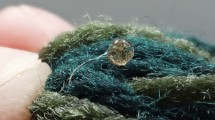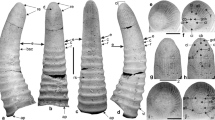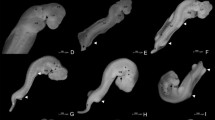Abstract
The true freshwater crabs (Crustacea, Decapoda, Brachyura) are highly adapted to life in freshwater and complete their life cycle entirely independently of sea water. All true freshwater crabs exhibit direct development and lack the free-living larval forms (zoea and megalopa) typical of most other brachyurans. After a prolonged embryonic period (during which they pass through the typical brachyuran larval forms embryologically) the eggs of true freshwater crabs hatch to produce juvenile (hatchling) crabs. We provide here the first report and description of the continuous record of embryonic development from egg-laying up to hatching in the Chinese true freshwater crab Sinopotamon yangtsekiense Bott, 1967 (Potamoidea, Potamidae). Direct development (complete secondary embryonization) in S. yangtsekiense was observed to take 77 days and to include an additional embryonic phase (termed here the egg-juvenile-crab) that occurs in the embryo between the imprisoned megalopa and the newly-emerged juvenile (hatchling) crab. This is significant because the only other freshwater crab whose embryonic development has been studied in detail is Potamon fluviatilis (Potamidae) which takes 45–47 days and involves only nine embryonic stages.
Similar content being viewed by others
References
Arshad A, Efrizal, Kamarudin M S, Saad C R. 2006. Study on fecundity, embryology and larval development of blue swimming crab Portunus Pelagicus (Linnaeus, 1758) under laboratory conditions research. Journal of Fisheries and Hydrobiology, 2006, 1(1): 35–44.
Anger K. 2005. The early life history of Sesarma fossarum, an endemic freshwater crab from Jamaica. Invertebrate Reproduction and Development, 47: 63–72.
Cuesta J A, Schuh M, Diesel R, Schubart C D. 1999. Abbreviated development of Armases miersii (Grapsidae: Sesarminae), a crab that breeds in supralittoral rock pools. Journal of Crustacean Biology, 19: 26–41.
Diesel R, Host D. 1995. Breeding in a snail shell: Ecology and Biology of the Jamaican montane crab Sesarma jarvisi (Decapoda: Grapsidae). Journal of Crustacean Biology, 15: 179–195.
Diesel R, Schubart C D, Schuh M. 2000. A reconstruction of the invasion of land by Jamaican crabs (Grapsidae: Sesarminae). J. Zool., 250: 141–160.
Giménez L, Anger K. 2003. Larval performance in an estuarine crab, Chasmagnathus granulata, is a consequence of both larval and embryonic experience. Marine Ecology-Progress Series, 249: 251–264.
Jeng M S, Clark P F, Ng P K L. 2004. The first zoea, megalopa, and first crab stage of the hydrothermal vent crab Xenograpsus testudinatus (decapoda: brachyura: grapsoidea) and the systematic implications for the varunidae. Journal of Crustacean Biology, 24: 188–212.
Martin J W, Davis G E. 2001. An updated classification of the recent crustacea. Natural History Museum of Los Angeles County. Science Series, 39: 1–124.
Ng P K L, Tan C G S. 1995. Geosesarma notophorum sp. nov. (Decapoda, Brachyura, Grapsidae, Sesarminae), a terrestrial crab from Sumatra, with novel brooding behaviour. Crustaceana, 68(3): 390–395.
Ng P K L, Guinot D, Davie P J F. 2008. System Brachyurorum: Part I. An annotated checklist of extant Brachyurancrabs of the world. The Raffles Bulletin of Zoology, 17: 1–286.
Pace F, Harris R R, Jaccarini V. 1976. The embryonic development of the Mediterranean freshwater crab, Potamon edulis (=P. fluviatile) (Crustacea, Decapoda, Potamonidae). Journal of Zoology, 180: 93–106.
Richer de Forges B, Jamieson B G M, Guinot D, Tudge C C. 1997. Ultrastructure of the spermatozoa of Hymenosomatidae (Crustacea: Brachyura) and the relationships of the family. Marine Biology, 130(2): 233–242.
Schuh M, Diesel R. 1995a. Effects of salinity and starvation on the larval development of Sesarma curacaoense De Man 1892, a mangrove crab with abbreviated development (Decapoda: Grapsidae). Journal of Crustacean Biology, 15: 645–654.
Schuh M, Diesel R. 1995b. Effects of salinity, temperature, and starvation on the larval development of Armases (=Sesarma) miersii (Rathbun, 1897), a semiterrestrial crab with abbreviated development (Decapoda: Grapsidae). Journal of Crustacean Biology, 15: 205–213.
Simith D J B, Diele K. 2008. Metamorphosis of mangrove crab megalopae, Ucides cordatus (Ocypodidae): Effects of interspecific versus intraspecific settlement cues. Journal of Experimental Marine Biology and Ecology, 362(2): 101–107.
Author information
Authors and Affiliations
Corresponding author
Additional information
Supported by the Shanghai Leading Academic Discipline Project (No. S30701) and the Leading Academic Discipline Project of Shanghai Municipal Education Commission (No. J50701)
Rights and permissions
About this article
Cite this article
Wu, H., Xue, J. & Cumberlidge, N. An extra embryonic phase in the true freshwater crab Sinopotamon yangtsekiense Bott, 1967 (Decapoda, Potamidae). Chin. J. Ocean. Limnol. 28, 725–730 (2010). https://doi.org/10.1007/s00343-010-9105-3
Received:
Accepted:
Published:
Issue Date:
DOI: https://doi.org/10.1007/s00343-010-9105-3




